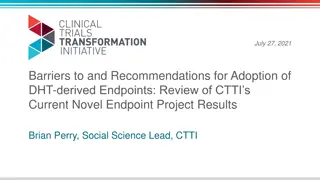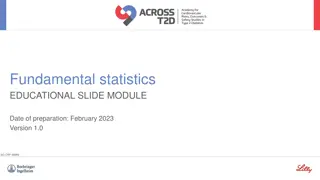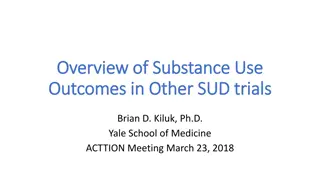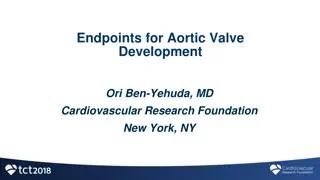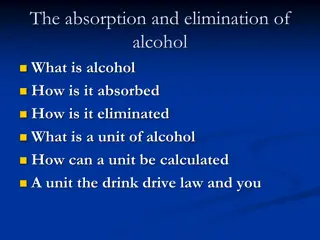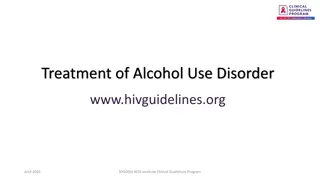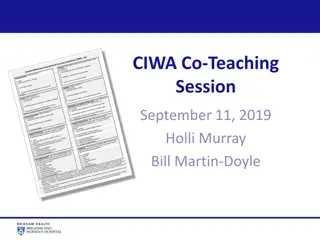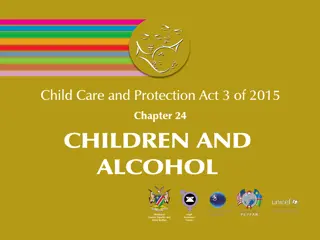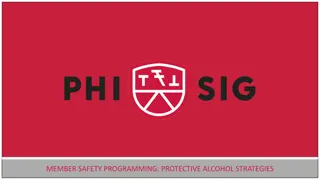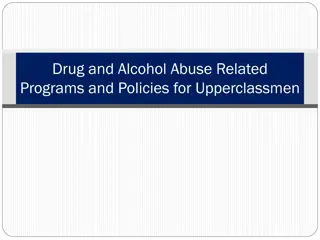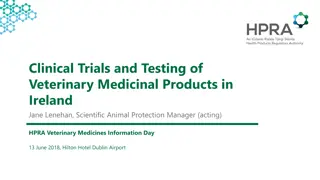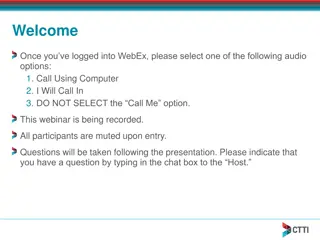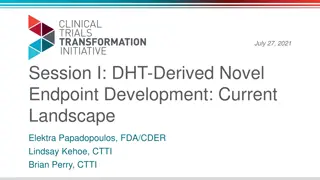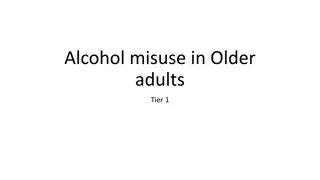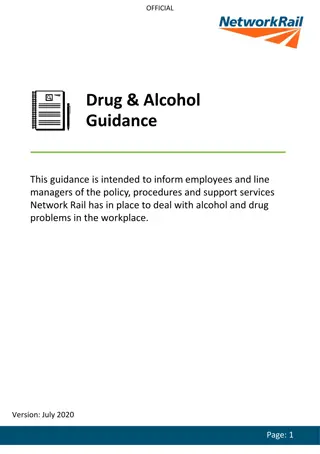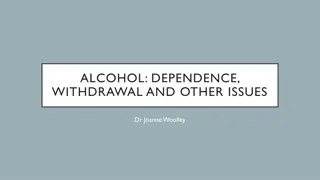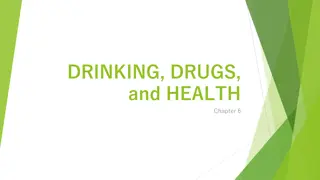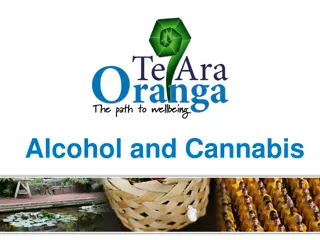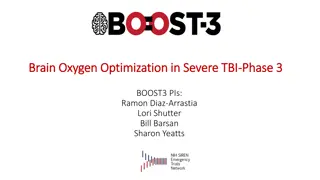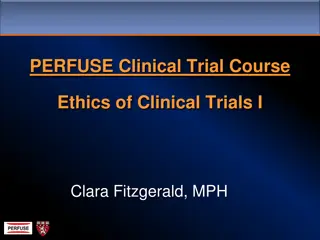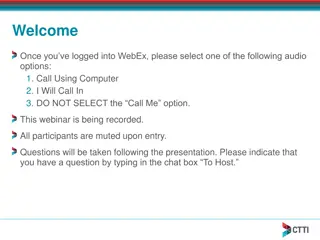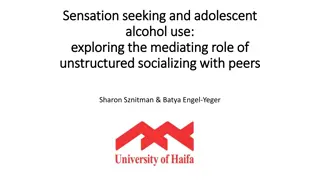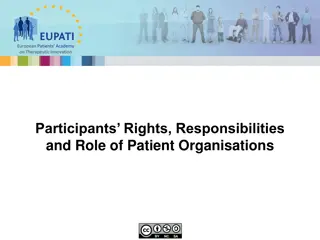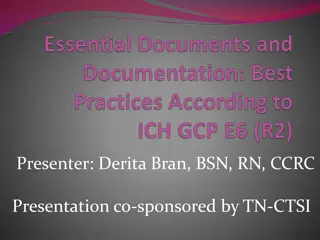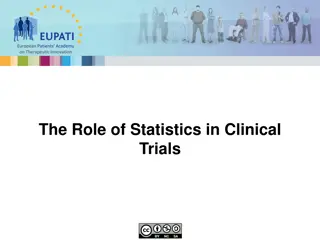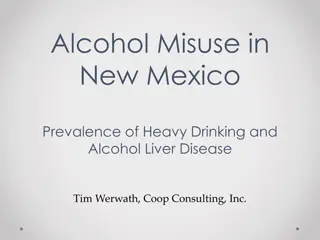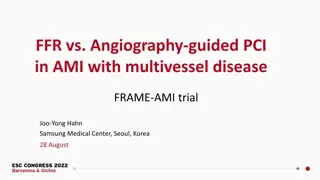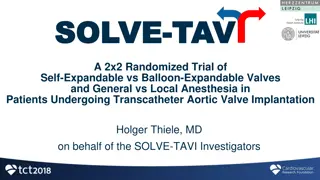Exploration of Endpoints in Clinical Trials for Alcohol Use Disorder
This presentation discusses the exploration of endpoints in pivotal clinical trials to treat Alcohol Use Disorder (AUD), focusing on Primary Alcohol Drinking Endpoints like PSNHDD. Evidence supporting PSNHDD as a primary endpoint includes clinical benefit data from alcohol clinical trials and epidemiologic studies. The COMBINE Trial, lasting 4 months with a 1-year follow-up, involving 1383 alcohol-dependent participants, demonstrated the efficacy of medications like naltrexone and acamprosate in combination with behavioral therapies.
Download Presentation

Please find below an Image/Link to download the presentation.
The content on the website is provided AS IS for your information and personal use only. It may not be sold, licensed, or shared on other websites without obtaining consent from the author. Download presentation by click this link. If you encounter any issues during the download, it is possible that the publisher has removed the file from their server.
E N D
Presentation Transcript
Exploration of Endpoints for Pivotal Exploration of Endpoints for Pivotal Clinical Trials to Treat AUD Clinical Trials to Treat AUD Raye Z. Litten, Ph.D. Daniel Falk, Ph.D. (Discussant) Division of Treatment and Recovery Research National Institute on Alcohol Abuse and Alcoholism Presented at the Measures of Outcome for Stimulant Trials (MOST) meeting of the ACTTION Initiative Rockville, MD, March 25, 2015
Key Organizations Key Organizations NIAAA NIAAA Dan Falk, Joanne Fertig, Megan Ryan ACTIVE Group ACTIVE Group FDA, EMA, pharmaceutical companies, academic researchers, NIAAA, NIDA
FDA Draft Guidance for Industry: FDA Draft Guidance for Industry: Primary Alcohol Drinking Endpoin Primary Alcohol Drinking Endpoints ts Dichotomous Measures Dichotomous Measures Percent Subjects Abstinent Percent Subjects with No Heavy Drinking Days (PSNHDD) Subjects with no heavy drinking days total number of subjects Heavy drinking day (HDD): 4 or more drinks/ drinking day for women and 5 or more drinks/drinking day for men PSNHDD includes abstinence and low-risk drinking
What evidence was provided for What evidence was provided for consideration of PSNHDD as a consideration of PSNHDD as a primary endpoint? primary endpoint?
Evidence of Clinical Benefit Evidence of Clinical Benefit (PSNHDD) (PSNHDD) Alcohol Clinical Trials Treatment Settings Epidemiologic Studies
Evidence of Clinical Benefit Evidence of Clinical Benefit (PSNHDD) (PSNHDD) Alcohol Clinical Trials Treatment Settings Epidemiologic Studies
COMBINE Trial COMBINE Trial Duration: 4 months treatment (1 year follow-up) Participants: alcohol dependent (n=1383) At Randomization: 3 to 21 days required abstinence Medications: naltrexone, acamprosate (alone and in combination) Behavioral therapies: Medical Management (MM) Combined Behavioral Intervention (CBI) Anton et al., JAMA 295: 2003-2017, 2006
Drinker Inventory of Consequences Drinker Inventory of Consequences (DRINC) (DRINC) 37-item alcohol-related consequences measure Four Subscales Physical (e.g., I have been sick and vomited after drinking ) Social responsibility (e.g., I have gotten into trouble because of drinking ) Interpersonal (e.g., I have lost a friend because of my drinking ) Impulse control (e.g., I have had an accident while drinking or intoxicated ) Miller et al., Project MATCH Monograph Series, 1995
Heavy Drinking increases DRINC Scores Heavy Drinking increases DRINC Scores at Follow at Follow- -Up Up 30 25 20.5 DRINC Score (37-item) 18.6 17.9 20 13.7 (Mean) 15 7.9 7.8 10 5.4 2.5 5 0 Treatment Months 3&4 Follow-up Month 2.5 Follow-up Month 9 Follow-up Month 12 No HDD (Months 3&4) HDD (Months 3&4) COMBINE Study
Abstainers and Low Risk have similar DRINC Scores Abstainers and Low Risk have similar DRINC Scores during Treatment and Follow during Treatment and Follow- -up up 25 DRINC Score (37-item) (Mean) 20.5 18.6 20 17.9 13.7 15 10.6 9.4 10 7.3 6.7 6.6 4.9 5 2.9 2.4 0 Treatment Follow-up Follow-up Follow-up Weeks 8-16 Months 3-4 Week 26 Month 2.5 Week 52 Month 9 Week 68 Month 12 Abstainers Low Risk HDD COMBINE Study
Abstainers and Low Risk have similar Drinks/Drinking Abstainers and Low Risk have similar Drinks/Drinking Day during Treatment and Follow Day during Treatment and Follow- -up up 9.8 10 9.1 9.1 Drinks per Drinking Day (Mean) 9 8.2 8 7 5.4 6 4.9 5 4.3 4.2 3.6 4 2.7 2.4 3 2 1 0 0 Treatment Follow-up Follow-up Follow-up Weeks 8-16 Months 3-4 Week 26 Month 2.5 Week 52 Month 9 Week 68 Month 12 Abstainers Low Risk HDD
Evidence of Clinical Benefit Evidence of Clinical Benefit (PSNHDD) (PSNHDD) https://encrypted-tbn0.gstatic.com/images?q=tbn:ANd9GcTfGQAESzq1nZaUWu24mKJJmddwyK1l-aVMRH3awzWwLcvv8FcO8g Alcohol Clinical Trials Treatment Settings Epidemiologic Studies
Kaiser Permanente Studies Kaiser Permanente Studies Study Site Study Site: : KP Chemical Dependency Recovery Program (CDRP) in Sacramento, California Participants Participants: : N = 995 adult patients (18+) with alcohol dependence/abuse Recruited from two randomized studies (Weisner et al., 2000, 2001) Predictor Predictor: Drinking Status (past 30 days) (6 months post : Drinking Status (past 30 days) (6 months post- -treatment) Abstinent Low-Risk Drinker: drank but no heavy drinking days (5+ drinks/drinking day) Heavy Drinker: 1+ heavy drinking days treatment) Outcomes Outcomes: : Addiction Severity Index (12 months post Addiction Severity Index (12 months post- -treatment) Medical Psychiatric Family/Social Employment treatment) Treatment Cost & Utilization (up to 5 years post Treatment Cost & Utilization (up to 5 years post- -treatment) treatment)
Clinical Relevance of Abstinent, Low Clinical Relevance of Abstinent, Low- -Risk, and Heavy Drinking Post Heavy Drinking Post- -Treatment Outcomes Treatment Outcomes Risk, and Compared with Abstinent Group: Low Low- -Risk Risk Heavy Drinking Heavy Drinking Drinking greater much greater Consequences: psychiatric/family/social problems similar higher Treatment Utilization: inpatient/ED similar higher Treatment Costs similar higher Kline-Simons et al. ACER 37(Suppl):E373-E380, 2013 and ACER 38:579-586, 2014
Evidence of Clinical Benefit Evidence of Clinical Benefit (PSNHDD) (PSNHDD) http://www.christopherboyer.com/wp-content/uploads/2013/06/evidence.jpg Alcohol Clinical Trials Treatment Settings Epidemiologic Studies
Epidemiologic Evidence: Epidemiologic Evidence: Clinical Benefit of PSNHDD Clinical Benefit of PSNHDD National Alcohol Surveys National Alcohol Surveys Treated or concerned drinkers who restrict alcohol intake to low volume and did not have any heavy drinking days had a low risk of alcohol dependence or abuse (Greenfield, unpublished data) National Epidemiologic Survey on Alcohol and National Epidemiologic Survey on Alcohol and Related Conditions (NESARC) Related Conditions (NESARC) Subjects with no heavy drinking days carried a much lower risk for alcohol dependence and AUD symptoms than those who experienced heavy drinking (Dawson et al. 2007)
Summary Summary No heavy drinking vs heavy drinking No heavy drinking decreases risk for relapse to heavy drinking and dependence, consequences, treatment utilization and cost compared to heavy drinking Abstinence vs low risk drinking vs heavy drinking Relapse to heavy drinking and dependence: heavy drinking>>low risk>abstinence Consequences: heavy drinking> low risk=abstinence Treatment utilization and cost: heavy drinking>low risk=abstinence N N
FDA Guidance: FDA Guidance: Clinical Benefit of PSNHDD Clinical Benefit of PSNHDD Patients who never exceeded the heavy drinking limits had minimal alcohol-related consequences and were much less likely to have relapsed at follow-up. -- FDA Guidance Summary Statement
Is PSNHDD a Sensitive Outcome in Is PSNHDD a Sensitive Outcome in Detecting Treatment Effects in Detecting Treatment Effects in Clinical Trials? Clinical Trials? https://encrypted-tbn3.gstatic.com/images?q=tbn:ANd9GcSw83VEUYcrdTezjklaQiR8me9SOuZVVQfUmrhi7777nPZmf53I2g
PSNHDD a Sensitive Endpoint? PSNHDD a Sensitive Endpoint? Not as sensitive as continuous outcome measures Number of heavy drinking days outcome was significant in five alcohol clinical trials PSNHDD was significant in only two of the trials Examples: COMBINE (PSNHDD sensitive) and varenicline trials (PSNHDD less sensitive) PSNHDD vs continuous outcome measures PSNHDD vs abstinence outcome
PSNHDD as Sensitive as Continuous PSNHDD as Sensitive as Continuous Measures (COMBINE) Measures (COMBINE) Naltrexone vs. Placebo Naltrexone vs. Placebo Measure Type Drinking Measure P Cohen d or h continuous % heavy drinking days <0.01 .23 continuous drinks/day 0.02 .19 continuous drinks/drinking day 0.01 .21 continuous % days abstinent 0.01 .21 dichotomous PSNHDD <0.01 .22 dichotomous % subjects abstinent 0.06 .15 Outcomes measured during last two months of treatment
Sensitivity of PSNHDD Depends on Sensitivity of PSNHDD Depends on Grace Period Grace Period Grace period a period in a trial where outcome is not considered in the analysis because the measured treatment effect is not thought to represent the full potential of the drug and the pattern of drinking is unstable
Percent Subjects with Abstinence (PSA), Naltrexone vs. Placebo, COMBINE (Missing Data Imputed) Cumulative Treatment Months - "Grace Periods" Naltrexone Placebo 100 h=.07 h=.13 h=.15 h=.24* 80 PSA (%) 60 38.4 40 31.1 27.2 25.2 24.3 20.5 19.7 17.7 20 0 1+2+3+4 2+3+4 3+4 4 * p < 0.05 Treatment Month
Percent Subjects with No Heavy Drinking Days (PSNHDDs), Naltrexone vs. Placebo, COMBINE (Missing Data Imputed) Cumulative Treatment Months - "Grace Periods" Naltrexone (N=302) Placebo (N=305) 100 h=.13 h=.17* h=.22** h=.26** 90 80 PSNHDDs (%) 70 60 53.3 50 44.0 40.3 37.1 40 33.4 32.8 26.9 29.2 30 20 10 0 1+2+3+4 2+3+4 3+4 4 Treatment Months
Percent Subjects with No Heavy Drinking Days (PSNHDDs), Naltrexone vs. Placebo, COMBINE (Missing Data Imputed) Cumulative Treatment Months - "Grace Periods" Naltrexone (N=302) Placebo (N=305) 100 h=.13 h=.17* h=.22** h=.26** 90 h=.07 h=.13 h=.15 h=.24* 80 PSNHDDs (%) 70 60 53.3 50 44.0 40.3 37.1 40 33.4 32.8 26.9 29.2 30 20 10 0 1+2+3+4 2+3+4 3+4 4 Treatment Months
Varenicline Varenicline Trial Trial Duration: 3 months treatment Participants: alcohol dependent (n=198) At Randomization: no required abstinence Medications: varenicline vs placebo Results: Varenicline significantly reduced many of continuous drinking measures: Did not significantly reduce dichotomous measures Litten et al. 2013. J Addict Med 7(4):277-86
PSNHDD not as Sensitive as Continuous PSNHDD not as Sensitive as Continuous Measures Measures Varenicline vs. Placebo Varenicline vs. Placebo Measure Type Drinking Measure P Cohen d or h continuous % heavy drinking days 0.01 .33 continuous drinks/day 0.02 .32 continuous drinks/drinking day 0.02 .29 continuous % days abstinent 0.20 .17 dichotomous PSNHDD 0.25 .10 dichotomous % subjects abstinence 0.68 .01
Percent Subjects Abstinent Percent Subjects Abstinent by Grace Period by Grace Period Placebo Varenicline 35% h=.01 h=.09 h=.12 30% 25% 20% PSA 15% 9.9% 10% 7.6% 6.7% 5.4% 5% 2.1% 2.0% 0% Maintenance Period (Weeks 2-13) Last 2 months Last Month all p>.05
Percent Subjects with No Heavy Drinking Percent Subjects with No Heavy Drinking Days Days by Grace Period by Grace Period Placebo Varenicline 35% h=.10 h=.10 h=.20 30% 27.5% 25% PSNHDD 18.9% 20% 15.2% 15% 11.8% 10% 7.3% 5.0% 5% 0% Maintenance Period (Weeks 2-13) all p>.05 Last 2 months Last Month
Percent Subjects with No Heavy Drinking Percent Subjects with No Heavy Drinking Days Days by Grace Period by Grace Period Placebo Varenicline 35% h=.10 h=.01 h=.10 h=.09 h=.20 h=.12 30% 27.5% 25% PSNHDD 18.9% 20% 15.2% 15% 11.8% 10% 7.3% 5.0% 5% 0% Maintenance Period (Weeks 2-13) all p>.05 Last 2 months Last Month
Summary Summary PSNHDD as an Endpoint Not as sensitive as continuous outcome measures Appears more sensitive than abstinence Need a grace period to show significance
Will allowing additional heavy Will allowing additional heavy drinking days (HDD) improve drinking days (HDD) improve treatment effect? treatment effect?
Cumulative Proportion of Cumulative Proportion of Responders Responders Analysis Analysis
Cumulative Proportion of Cumulative Proportion of Responder Analysis Responder Analysis Presents the proportion of responders over the entire range of possible cut- off points on a graph Takes number of HDDs and creates all possible dichotomizations using different cut-offs (e.g, 0 HDD, <=1 HDD, <=2 HDD, etc)
Treatment Effect Improves with More Treatment Effect Improves with More Lenient Outcomes . Lenient Outcomes . COMBINE Study (Months 2-4) Placebo Naltrexone h 100 1.0 90 0.9 Proportion of Responders (%) 80 0.8 70 0.7 Treatment Effect (h) 60 0.6 50 0.5 40 0.4 30 0.3 20 0.2 10 0.1 0 0.0 84 82 80 78 76 74 72 70 68 66 64 62 60 58 56 54 52 50 48 46 44 42 40 38 36 34 32 30 28 26 24 22 20 18 16 14 12 10 8 6 4 2 0 < X Heavy Drinking Days during Treatment Falk et al., J Stud Alcohol Drugs 75:335-346, 2014
yet Alcohol yet Alcohol- -Related Consequences increase with Related Consequences increase with additional Heavy Drinking Days (more lenient additional Heavy Drinking Days (more lenient outcomes) outcomes) 35 30 27.3 DrInC Total Score (mean) 25 21.6 20 18.1 18.0 16.2 17.8 15 13.6 11.9 10.1 9.6 9.4 10 7.9 8.8 6.3 5 2.5 0 0 1 2 3 4 5 6 7-8 9-10 11-12 13-14 15-20 21-27 28-39 40-56 Falk et al. Alcohol Clin Exp Res 34:2022-2032, 2010 Number of Heavy Drinking Days
What new analyses are being What new analyses are being conducted to expand primary conducted to expand primary endpoints for Alcohol Clinical endpoints for Alcohol Clinical Trials? Trials?
https://encrypted-tbn2.gstatic.com/images?q=tbn:ANd9GcQDYttLKOhj3LSER2b1Z6HxoOvFwbUZA-f1RjsG88Yt8Sh7zHHbLghttps://encrypted-tbn2.gstatic.com/images?q=tbn:ANd9GcQDYttLKOhj3LSER2b1Z6HxoOvFwbUZA-f1RjsG88Yt8Sh7zHHbLg New Analyses New Analyses Develop and validate more sensitive and clinically meaningful outcome measures Reduction of continuous drinking outcomes Drinking categories of drinking levels and patterns Non-drinking outcomes
New Analyses New Analyses Data Sets of Different Alcohol Studies Rehm s chronic disease COMBINE, MATCH, NCIG trials NESARC and other large epidemiological surveys Kaiser and other HMO Research Networks
Validation of Clinical Significance of Validation of Clinical Significance of Reduction in Reduction in Continuous Continuous Drinking Outcomes Outcomes Drinking https://encrypted-tbn3.gstatic.com/images?q=tbn:ANd9GcRS7gJ1C_b5U6kwbUfhzynUDfrxkRDOtTDnga14aIggjs6XPNucgQ Validate drinking against: alcohol-related consequences https://encrypted-tbn1.gstatic.com/images?q=tbn:ANd9GcRq9YgyZcwy1V0fCab6nvjdVgblpNOl_kAPPbgmWU3ccQKd08j0 treatment utilization treatment cost
Malignant Neoplasms Malignant Neoplasms Source: Lim et al. 2012
Rehms Rehm s Chronic Disease Data Chronic Disease Data Drinks per day (DPD) Drinks per day (DPD): : Varenicline = 4.4 vs. Placebo = 5.4 Varenicline = 4.4 vs. Placebo = 5.4 (Litten et al., 2013) Is this ~ 1 DPD difference clinically meaningful? Is this ~ 1 DPD difference clinically meaningful? Mouth and Oral Cancer (Litten et al., 2013) Placebo (RR=4.4) Varenicline (RR= 3.5)
Microsimulation Microsimulation Model to Estimate Clinical Model to Estimate Clinical Relevance of Reducing Alcohol Consumption Relevance of Reducing Alcohol Consumption Number of Events per 100,000 Patients by Total Alcohol Consumption category per year Francois, Rehm et al, Eur Addict Res 20:269-284, 2014
Microsimulation Microsimulation Model to Estimate Clinical Model to Estimate Clinical Relevance of Reducing Alcohol Consumption Relevance of Reducing Alcohol Consumption Number of Events per 100,000 Patients by HDDs per year Francois, Rehm et al, Eur Addict Res 20:269-284, 2014
Applying Microsimulation Model to Applying Microsimulation Model to Nalmafene Nalmafene Trial Outcomes Trial Outcomes Difference between nalmefene and placebo groups ~1 drink/day = 692 fewer alcohol-attributable diseases and injuries/1000,000 alcohol dependent patients per year 3 heavy drinking days/month = 941 fewer Francois, Rehm et al, Eur Addict Res 20:269-284
Development of Risk Categories of Development of Risk Categories of Alcohol Intake Alcohol Intake Establish categories describing the risks/benefits at different levels and patterns of drinking Establish categories similar to clinical categories developed for blood pressure, cholesterol, and glycated hemoglobin
Categories for Blood Pressure (BP) Categories for Blood Pressure (BP) BP Systolic BP mm Hg Diastolic BP mm Hg What to do Classification Normal <120 <80 Healthy lifestyle Pre-Hypertension 120-139 80-89 Healthy lifestyle Stage 1 Hypertension 140-159 90-99 Healthy lifestyle and medication Stage 2 Hypertension >160 >99 Healthy lifestyle and medications
Hypothetical Categories for Alcohol Consumption Hypothetical Categories for Alcohol Consumption Cut-Off Values Classification: Levels of Drinking (based on risk/benefits associated with non- drinking outcomes) Abstinence No drinking Not exceeds weekly limits (< 7/14 drinks/week for females/males) AND No heavy drinking days (HDDs) Low-Risk Drinking Exceeds weekly (< 21/28 drinks/week) OR HDDs (up to 3x/month) Stage 1 (Low) High-Risk Drinking Stage 2 (Moderate) High-Risk Drinking Exceeds weekly (< 49/56 drinks/week) AND HDDs (up to 4x/week) Stage 3 (Severe) High-Risk Drinking Exceeds weekly (> 49/56 drinks/week) AND HDDs (daily or near daily/week) Valuable information to stakeholders: regulatory agencies, pharmaceutical industry, researchers, patients, clinicians, and third-party payers
WHO Risk Level WHO Risk Level Who Risk Level Definition Men: none Women: none Abstinence Men: 1-40g (<2.9 drinks) Women 1-20g (<1.4 drinks) Low Men: 40-60g (2.9-4.3 drinks) Women 20-40g (1.4-2.9 drinks) Medium Men: 60-100g (4.3-7.1 drinks) Women 40-60g (2.9-4.3 drinks) High Men: 100+g (7.1+ drinks) Women 60+g (4.3+ drinks) Very high World Health Organization s gender-specific levels of risk Standard drink = 14g = 0.6 oz of alcohol
Develop and Validate Develop and Validate Non Non- -Drinking Outcomes Drinking Outcomes Validate Patient Validate Patient- -Reported Outcomes (PRO) Reported Outcomes (PRO) under FDA s Clinical Outcome Assessments under FDA s Clinical Outcome Assessments (COA): (COA): Alcohol-Related Consequences: Lilly started validation of DRINC, resulting in 15-item measure (IMBIBE) Craving: not yet started


